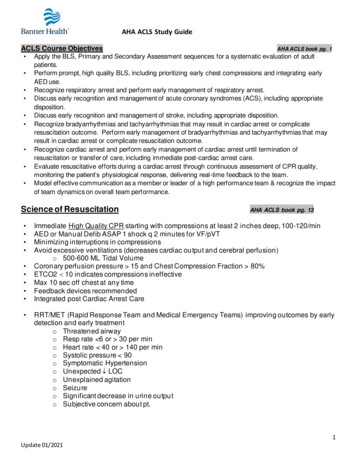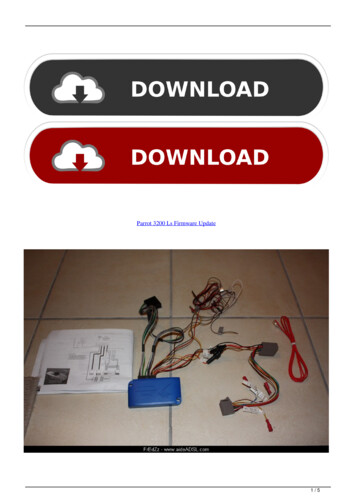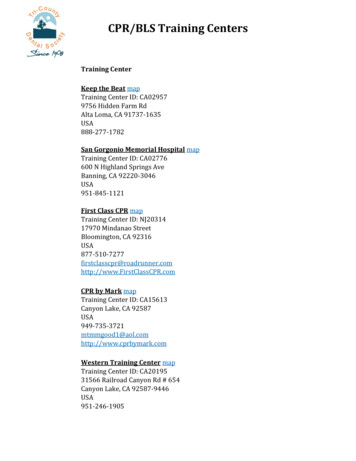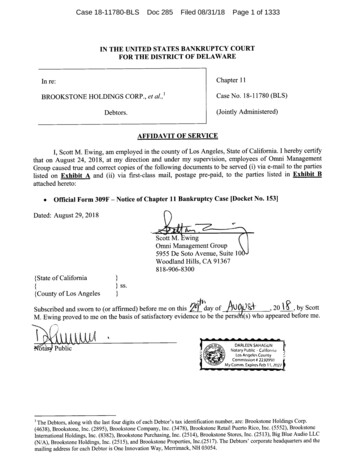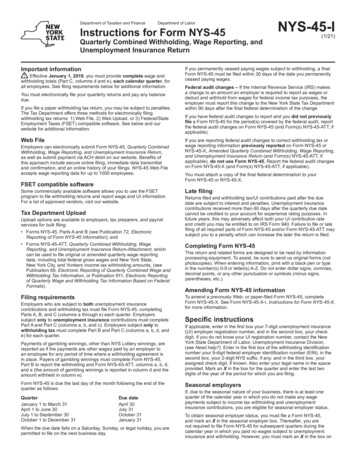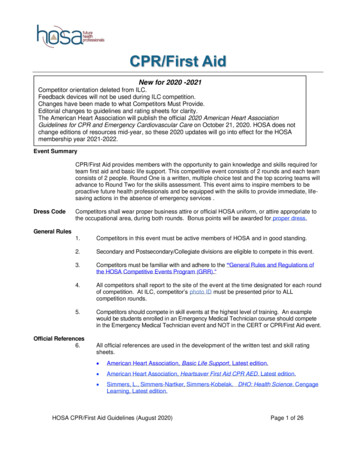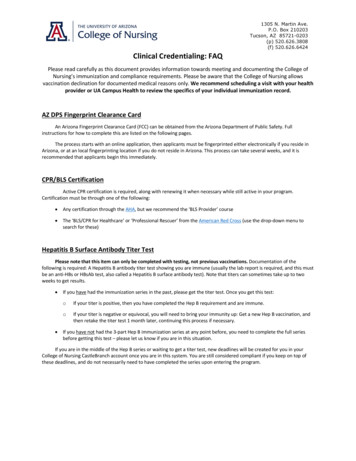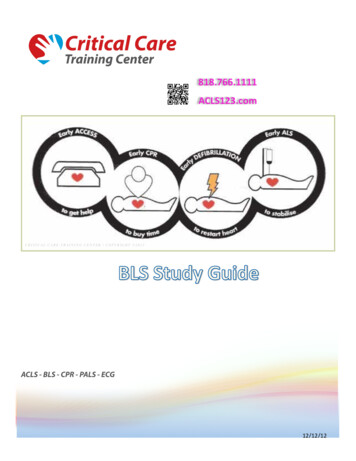
Transcription
818.766.1111ACLS123.comC R I T I C A L C A R E T R A I N I N G C E N T E R C O P Y R I G H T 2 0 1 212/12/12
Course OverviewThis study guide is an outline of content that will be taught in the American Heart AssociationAccredited Basic Life Support (BLS) Course. It is intended to summarize important content, butsince all BLS content cannot possibly be absorbed in a class given every two years, it is expectedthat the student will have the 2010 Updated ECC Handbook readily available for review as areference. The student is also required to have the AHA BLS Textbook available for referenceand study for more in depth content.Evidence Based UpdatesApproximately every 5 years the AHA updates the guidelines for CPR and EmergencyCardiovascular Care. These updates are necessary to ensure that all AHA courses contain thebest information and recommendations that can be supported by current scientific evidenceexperts from outside the United States and outside the AHA. The guidelines were thenclassified as to the strength of evidence that supportsthe recommendation.CriticalConceptsHigh- Thecriticalcharacteristicsofhigh- entilations keychangesandissues: hasisonhigh- secheckandAEDuseininfants
ChangesinSequence:C- ‐A- ‐B–NOT–A- ‐B- ‐CIntheA- ‐B- etherescueropenedtheairwaytogivemouth- ‐to- encetoC- ‐A- approximately18secondsorless;for2- er).EmphasisonHigh- ‐QualityCPR ofatleastonethirdoftheanterior- ‐posterior dchildren.Thisis thattherangeof1½to2inchesisnolongerused ontinuestobeimportantcomponentsofhigh- ‐qualityCPR.Continuedde- ‐emphasisofthepulsecheckUseofanAEDforinfants ediatricdoseattenuator reunabletoreliablydetectapulse ralinachild) fyoufeelapulse,beginchestcompressions.
BLS/CPRforAdultsBLSConsistofthesemainparts owtheseinitialBLSstepsforadults1. onormalbreathing(i.e.,onlygasping),shoutforhelp.2. evictim.3. 0seconds)4. ithcompressions(C- ‐A- ‐Bsequence)Step1:AssessmentandSceneSafety ncheckthevictimforaresponse.o tetheemergencyresponsesystem.IF IN THE HOSPITAL, CALL THE etandAED andbeginCPR(C- ‐A- ‐Bsequence).Step3:PulseCheck checkforpulseStep4:CPR erescuershouldusethecompression- .« « « « « « « « « « « « « « « « « « « «
MovingtheVictim ayforBreaths:HeadTilt- ‐ChinLift1. almtotilttheheadback2. lowerjawnearthechin3. MaskBreaths1. Positionyourselfatthevictim’sside2. enoseasaguideforcorrectposition.3. Sealthemaskagainsttheface:’a. k.b. hemask4. nymarginofthejawandliftthejaw.Performaheadtilt- ‐chinlifttoopentheairway5. 6. UsingtheBag- ‐MaskDuring2- ‐RescuerCPRThebag- ‐maskventilation1. Positionyourselfdirectlyabovethevictim’shead2. itionandpracticeandisnot3. rescuerduringCPRa. Performaheadtiltb. geofthenosec. e.d. themask4. rornotyouusesupplementaloxygen.
Atthevictim’ssideDuties Performchestcompressions. Compressthechestatleast2inches(5cm) Compressatarateofatleast100/min n. nterruptionsinchestcompressionto 10seconds) CountCompressionsaloud t2minutes,taking 5secondstoswitch Maintainanopenairwayusingeither Headtilt- ‐chinlift Jawthrust siveventilation coilbetweencompressions. 2minutes,taking thmuchforce.
eps) OpenthecarryingcaseorthetopoftheAED ctim’sbarechest. im’s8yearsofageandolder PeelthebackingawayfromtheAEDpads AttachtheadhesiveAEDpadstothevictim’sbarechest. PlaceonAEDpadonthevictim’supper- ‐rightchest(directlybelowthecollarbone) pedgeofthepadafewinchesbelowthearmpit connected)“Clear”thevictimandANALYZEtherhythm argeofgivingbreaths. cally.TheAEDmaytakeabout5to15secondstoanalyze. toshock,itwilltellyoutoclearthevictim istouchingthevictim verybodyclear”orsimply“Clear” Looktobesurenooneisincontactwiththevictim. PresstheSHOCKbutton TANDARDPADS,MAKINGSURETHEYDONOTTOUCHOROVERLAP
LSare: Compression- ‐ventilationratiofor2- ‐rescuerCPR:15:2ratiofor2- activetheemergencyresponsesystem:o cyresponsesystemandgettheAED(ordefibrillator)o sHigh- .Thecriticalcharacteristicsofhigh- ‐qualityCPRinadultsincludes: CompressionRateandRatioforLoneRescuer Thelonerescuershouldusetheuniversalcompression- rtrateis arrives,usecompressions–to–breathsratioof15:2. fectivebreathsAvoidexcessiveventilations
fantBLSare: pproximately1½inches(4cm)Compression- yresponsesystem(sameasforchild):o yresponsesystemandgettheAED(ordefibrillator).o 2- tone- nsinchestcompressions.
ingthe2thumbs–encirclinghandtechnique.1. erlapinverysmallinfants.2. he2thumb- hniquesisthe3. Withyourhandsencirclingthechest,usebothpreferred2- ‐resucer- nches{4cm})canfittheirhandsaround4. t100/mintheinfant’schest.5. ebreastboneandallowthechesttorecoilcompletely6. escuertoopentheairwaywiththeheadtilt- eachbreath.7. hniqueandInfant)NoAdvanced 15compressionsto2Airway(mouth- ‐breaths 30compressionsto2breathsto- ‐mouth,mouth- ‐to- ‐mask, Compressionrateofatleast100/min Compressionrateofatbag- ‐mask)least100/minAdvancedairway aths(endotrachealintubation, ngealmaskairway,supraglottic)
andventilation,thepulseis on.Thisisrescuebreathing. ndChildrenGiven1breathevery5to6seconds minute)(about12to20breathsperminute) Giveeachbreathin1second Eachbreathshouldresultinvisiblechestrise s.ActivatetheemergencyresponsesystemandstartCPR(C- ‐A- ‐Bsequence).
sAirwayCompression- hing(C- ‐A- o 10secondsHeadtilt- 8seconds(8- mericanHeartAssociation.
This study guide is an outline of content that will be taught in the American Heart Association Accredited Basic Life Support (BLS) Course. It is intended to summarize important content, but since all BLS content cannot possibly be absorbed in a class given every two years, it is expected
